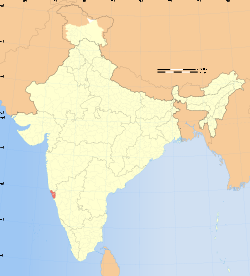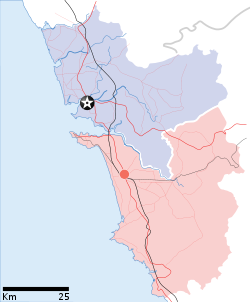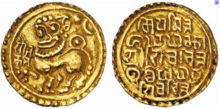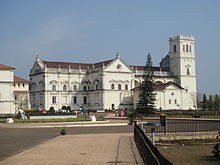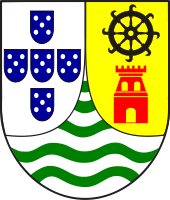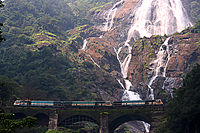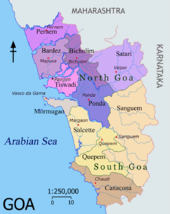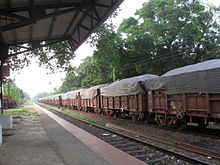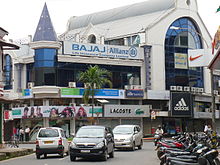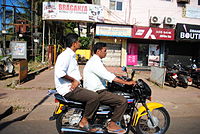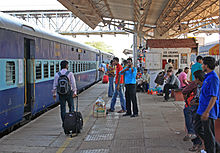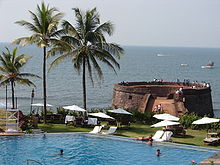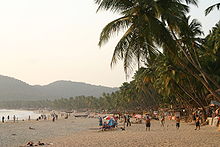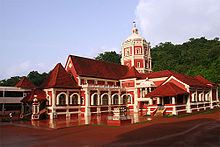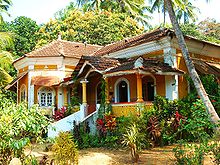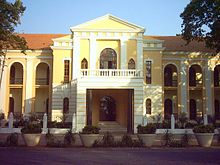
Goa
Background to the schools Wikipedia
SOS Children offer a complete download of this selection for schools for use on schools intranets. SOS Child sponsorship is cool!
| Goa | |||
|---|---|---|---|
| — State — | |||
|
|||
| Location of Goa in India | |||
| Map of Goa | |||
| Coordinates (Panaji): 15°29′56″N 73°49′40″E Coordinates: 15°29′56″N 73°49′40″E | |||
| Country | |||
| Established | 30 May 1987 | ||
| Capital | Panaji | ||
| Largest city | Vasco da Gama | ||
| Districts | 2 | ||
| Government | |||
| • Governor | Bharat Vir Wanchoo | ||
| • Chief Minister | Manohar Parrikar ( BJP) | ||
| • Legislature | Unicameral (40 seats) | ||
| • Parliamentary constituency | 2 | ||
| • High Court | Bombay High Court - Panaji, Goa Bench | ||
| Area | |||
| • Total | 3,702 km2 (1,429 sq mi) | ||
| Area rank | 28th | ||
| Population (2011) | |||
| • Total | 1,457,723 | ||
| • Rank | 25th | ||
| • Density | 390/km2 (1,000/sq mi) | ||
| Time zone | IST ( UTC+05:30) | ||
| ISO 3166 code | IN-GA | ||
| HDI | |||
| HDI rank | 3rd (2005) | ||
| Literacy | 87% (3rd) | ||
| Official languages | Konkani | ||
| Website | www.goa.gov.in | ||
| ^* Konkani is the sole official language but Marathi is also allowed to be used for any or all official purposes. | |||
Goa / ˈ ɡ oʊ . ə / is India's smallest state by area and the fourth smallest by population. Located in West India in the region known as the Konkan, it is bounded by the state of Maharashtra to the north, and by Karnataka to the east and south, while the Arabian Sea forms its western coast. Goa is India's richest state with a GDP per capita two and a half times that of the country as a whole. It was ranked the best placed state by the Eleventh Finance Commission for its infrastructure and ranked on top for the best quality of life in India by the National Commission on Population based on the 12 Indicators.
Panaji is the state's capital, while Vasco da Gama is the largest city. The historic city of Margao still exhibits the cultural influence of the Portuguese, who first landed in the early 16th century as merchants and conquered it soon thereafter. Goa is a former Portuguese colony, the Portuguese overseas territory of Portuguese India existed for about 450 years until it was annexed by India in 1961.
Renowned for its beaches, places of worship and world heritage architecture, Goa is visited by large numbers of international and domestic tourists each year. It also has rich flora and fauna, owing to its location on the Western Ghats range, which is classified as a biodiversity hotspot.
Etymology
In ancient literature, Goa was known by many names such as Gomanta, Gomanchala, Gopakapattam, Gopakapuri, Govapuri, Govem, and Gomantak. The Indian epic Mahabharata refers to the area now known as Goa, as Goparashtra or Govarashtra which means a nation of cowherds. Gopakapuri or Gopakapattanam were used in some ancient Sanskrit texts, and these names were also mentioned in other sacred Hindu texts such as the Harivansa and the Skanda Purana. In the third century BCE, Goa was known as Aparantha, and is mentioned by the Greek geographer Ptolemy. The Greeks referred to Goa as Nelkinda in the 13th century. Some other historical names for Goa are Sindapur, Sandabur, and Mahassapatam.
History
Goa's history goes back to 20,000–30,000 years. The rock art engravings exhibit earliest traces of human life in India. Upper Paleolithic or Mesolithic rock art engravings have been found on the bank of river Kushavati at Usgalimal. Petroglyphs, cones, stone-axe, and choppers dating back 10,000 years back have been found in many places in Goa like Kazur, Mauxim, and the Mandovi- Zuari basin. Palaeolithic cave existence is seen at Dabolim, Adkon, Shigao, Fatorpa, Arli, Maulinguinim, Diwar, Sanguem, Pilerne, and Aquem-Margaon etc. Difficulty in carbon dating the laterite rock compounds poses problems in determination of exact time period. These discoveries have shed light on Goa's prehistory. Its ancient name was "Revti Dweep".
The Sumerians inhabited Goa around 2200 BC which was followed by several waves of Indo-Aryan people and the Dravidians from the Deccan. The early Goan society underwent radical changes when aboriginal locals and the migrants amalgamated, forming the base of early Goan culture.
In the 3rd century BC, it formed part of the Maurya Empire, ruled by the Buddhist emperor, Ashoka of Magadha. Buddhist monks laid the foundation of Buddhism in Goa. Between the 2nd century BCE and the 6th century CE, Goa was ruled by the Chutus of Karwar as feudatories of the Satavahanas of Kolhapur (2nd century BCE to the 2nd century CE), Western Kshatrapas (around 150 CE), the Abhiras of Western Maharashtra, Bhojas of the Yadav clans of Gujarat, and the Konkan Mauryas as feudatories of the Kalachuris. The rule later passed on to the Chalukyas of Badami, who controlled it between 578 to 753, and later the Rashtrakutas of Malkhed from 753 to 963. However from 765 to 1015, the Southern Silharas of Konkan ruled Goa as the feudatories of the Chalukyas and the Rashtrakutas. Over the next few centuries, Goa was successively ruled by the Kadambas as the feudatories of the Chalukyas of Kalyani. They patronised Jainism in Goa.
In 1312, Goa came under the governance of the Delhi Sultanate. However, the kingdom's grip on the region was weak, and by 1370 they were forced to surrender it to Harihara I of the Vijayanagara empire. The Vijayanagara monarchs held on to the territory until 1469, when it was appropriated by the Bahmani sultans of Gulbarga. After that dynasty crumbled, the area fell to the hands of the Adil Shahis of Bijapur who established as their auxiliary capital the city known under the Portuguese as Velha Goa.
In 1510, the Portuguese defeated the ruling Bijapur sultan Yousuf Adil Shah with the help of a local ally, Timayya, leading to the establishment of a permanent settlement in Velha Goa (or Old Goa).
In 1843 the capital was moved to Panjim from Velha Goa. By the mid-18th century the area under occupation had expanded to most of Goa's present day state limits. Simultaneously the Portuguese lost other possessions in India until their borders stabilised and formed the Estado da Índia Portuguesa, of which Goa was the largest territory.
After India gained independence from the British in 1947, Portugal refused to negotiate with India on the transfer of sovereignty of their Indian enclaves. On 19 December 1961, the Indian Army commenced with Operation Vijay resulting in the annexation of Goa, Daman, and Diu into the Indian union. Goa, along with Daman and Diu, was made into a centrally administered union territory of India. On 30 May 1987, the union territory was split, and Goa was made India's twenty-fifth state, with Daman and Diu remaining a union territory.
Geography and climate
Geography
Goa encompasses an area of 3,702 km2 (1,429 sq mi). It lies between the latitudes 14°53′54″ N and 15°40′00″ N and longitudes 73°40′33″ E and 74°20′13″ E. Most of Goa is a part of the coastal country known as the Konkan, which is an escarpment rising up to the Western Ghats range of mountains, which separate it from the Deccan Plateau. The highest point is the Sonsogor, with an altitude of 1,167 meters (3,827 feet). Goa has a coastline of 101 km (63 mi).
Goa's main rivers are Mandovi, Zuari, Terekhol, Chaporakushavati river and the Sal. The Mormugao harbour on the mouth of the River Zuari is one of the best natural harbours in South Asia. The Zuari and the Mandovi are the lifelines of Goa, with their tributaries draining 69% of its geographic area. These rivers are some of the busiest rivers in India. Goa has more than forty estuarine, eight marine and about ninety riverine islands. The total navigable length of Goa's rivers is 253 km (157 mi). Goa has more than three hundred ancient tanks built during the rule of the Kadamba dynasty and over a hundred medicinal springs.
Most of Goa's soil cover is made up of laterites which are rich in ferric aluminium oxides and reddish in colour. Further inland and along the riverbanks, the soil is mostly alluvial and loamy. The soil is rich in minerals and humus, thus conducive to plantation. Some of the oldest rocks in the Indian subcontinent are found in Goa between Molem and Anmod on Goa's border with Karnataka. The rocks are classified as Trondjemeitic Gneiss estimated to be 3,600 million years old, dated by the Rubidium isotope dating method. A specimen of the rock is exhibited in the Goa University.
Climate
Goa features a tropical monsoon climate under the Köppen climate classification. Goa, being in the tropical zone and near the Arabian Sea, has a hot and humid climate for most of the year. The month of May is the hottest, seeing day temperatures of over 35 °C (95 °F) coupled with high humidity. The monsoon rains arrive by early June and provide a much needed respite from the heat. Most of Goa's annual rainfall is received through the monsoons which last till late September.
Goa has a short winter season between mid-December and February. These months are marked by nights of around 21 °C (68 °F) and days of around 28 °C (84 °F) with moderate amounts of humidity. Further inland, due to altitudinal gradation, the nights are a few degrees cooler. During March 2008 Goa was lashed with heavy rain and strong winds. This was the first time in 29 years that Goa had seen rain during March.
| Climate data for Goa | |||||||||||||
|---|---|---|---|---|---|---|---|---|---|---|---|---|---|
| Month | Jan | Feb | Mar | Apr | May | Jun | Jul | Aug | Sep | Oct | Nov | Dec | Year |
| Average high °C (°F) | 31.6 (88.9) |
31.5 (88.7) |
32.0 (89.6) |
33.0 (91.4) |
33.0 (91.4) |
30.3 (86.5) |
28.9 (84) |
28.8 (83.8) |
29.5 (85.1) |
31.6 (88.9) |
32.8 (91) |
32.4 (90.3) |
31.28 (88.3) |
| Daily mean °C (°F) | 25.6 (78.1) |
26.0 (78.8) |
27.6 (81.7) |
29.3 (84.7) |
29.7 (85.5) |
27.5 (81.5) |
26.5 (79.7) |
26.4 (79.5) |
26.7 (80.1) |
27.7 (81.9) |
27.6 (81.7) |
26.5 (79.7) |
27.26 (81.08) |
| Average low °C (°F) | 19.6 (67.3) |
20.5 (68.9) |
23.2 (73.8) |
25.6 (78.1) |
26.3 (79.3) |
24.7 (76.5) |
24.1 (75.4) |
24.0 (75.2) |
23.8 (74.8) |
23.8 (74.8) |
22.3 (72.1) |
20.6 (69.1) |
23.21 (73.78) |
| Precipitation mm (inches) | 0.2 (0.008) |
0.1 (0.004) |
1.2 (0.047) |
11.8 (0.465) |
112.7 (4.437) |
868.2 (34.181) |
994.8 (39.165) |
512.7 (20.185) |
251.9 (9.917) |
124.8 (4.913) |
30.9 (1.217) |
16.7 (0.657) |
2,926 (115.2) |
| Avg. precipitation days | 0.0 | 0.0 | 0.1 | 0.8 | 4.2 | 21.9 | 27.2 | 13.3 | 13.5 | 6.2 | 2.5 | 0.4 | 90.1 |
| Mean monthly sunshine hours | 313.1 | 301.6 | 291.4 | 288.0 | 297.6 | 126.0 | 105.4 | 120.9 | 177.0 | 248.0 | 273.0 | 300.7 | 2,842.7 |
| Source: World Meteorological Organization (UN), Hong Kong Observatory for data of sunshine hours | |||||||||||||
Subdivisions
The state is divided into two districts: North Goa and South Goa. Each district is governed by a district collector, an administrator appointed by the Indian government.
North Goa District
Panaji is the headquarters of the North Goa district.
The North Goa District is further divided into four subdivisions – Panaji, Bicholim, Mapusa and Ponda; and six taluks – Tiswadi ( Panaji), Bardez ( Mapusa), Pernem, Bicholim, Sattari ( Valpoi), and Ponda.
South Goa District
Margao is the headquarters of the South Goa district.
The South Goa District is further divided into three subdivisions – Margao, Mormugao ( Vasco da Gama), and Quepem; and six taluks – Mormugao, Salcete ( Margao), Quepem, Canacona ( Chaudi), Sanguem, and Dharbandora.
Municipalities
Goa's major cities include Vasco da Gama, Margao, Panaji, Mapusa and Ponda.
Municipal Corporation (1): Panaji
Municipal Councils (13): Margao, Mormugao (including Vasco da Gama), Pernem, Mapusa, Bicholim, Sanquelim, Valpoi, Ponda, Cuncolim, Quepem, Curchorem, Sanguem, and Canacona.
Flora and fauna
Equatorial forest cover in Goa stands at 1,424 km2 (549.81 sq mi), most of which is owned by the government. Government owned forest is estimated at 1,224.38 km2 (472.74 sq mi) whilst private is given as 200 km2 (77.22 sq mi). Most of the forests in the state are located in the interior eastern regions of the state. The Western Ghats, which form most of eastern Goa, have been internationally recognised as one of the biodiversity hotspots of the world. In the February 1999 issue of National Geographic Magazine, Goa was compared with the Amazon and Congo basins for its rich tropical biodiversity.
Goa's wildlife sanctuaries boast of more than 1512 documented species of plants, over 275 species of birds, over 48 kinds of animals and over 60 genera of reptiles.
Rice is the main food crop with pulses, ragi and other food crops are also grown. Main cash crops are coconuts, cashewnuts, arecanuts, sugarcane and fruits like pineapples, mangos and bananas. The State has a rich forest cover of more than 1,424 km². Goa's state animal is the Gaur, the state bird is the Ruby Throated Yellow Bulbul, which is a variation of Black-crested Bulbul, and the state tree is the Asan.
The important forests products are bamboo canes, Maratha barks, chillar barks and the bhirand. Coconut trees are ubiquitous and are present in almost all areas of Goa barring the elevated regions. A large number of deciduous vegetation consisting of teak, sal, cashew and mango trees are present. Fruits include jackfruits, mangos, pineapples and 'black-berry' ('podkoam' in konkani). Goa's forests are rich with medicinal plants.
Foxes, wild boars and migrating birds are found in the jungles of Goa. The avifauna includes kingfishers, mynas and parrots. Numerous types of fish are also caught off the coast of Goa and in its rivers. Crabs, lobsters, shrimps, jellyfish, oysters and catfish form some of the piscine catch. Goa also has a high snake population, which keeps the rodent population under control. Goa has many famous National Parks, including the renowned Salim Ali bird sanctuary. Other wildlife sanctuaries include the Bondla Wildlife Sanctuary, Molem Wildlife Sanctuary, Cotigao Wildlife Sanctuary, Madei Wildlife Sanctuary, Netravali Wildlife Sanctuary, Mahaveer Wildlife Sanctuary and the Salim Ali Bird Sanctuary located on the island of Chorao.
Goa has more than 33% of its geographic area under government forests (1224.38 km²) of which about 62% has been brought under Protected Areas (PA) of Wildlife Sanctuaries and National Park. Since there is a substantial area under private forests and a large tract under cashew, mango, coconut, etc. plantations, the total forest and tree cover constitutes 56.6% of the geographic area.
Economy
| Gross State Domestic Product (in millions of Rupees) | |
| Year | GSDP |
|---|---|
| 1980 | 3,980 |
| 1985 | 6,550 |
| 1990 | 12,570 |
| 1995 | 33,190 |
| 2000 | 76,980 |
Goa's gross state domestic product for 2007 is estimated at $3 billion in current prices. Goa is one of India's richest states with the highest GDP per capita — two and a half times that of the country as a whole — and one of its fastest growth rates: 8.23% (yearly average 1990–2000). Tourism is Goa's primary industry: it handles 12% of all foreign tourist arrivals in India. Goa has two main tourist seasons: winter and summer. In the winter time, tourists from abroad (mainly Europe) come to Goa to enjoy the climate. In the summer time (which, in Goa, is the rainy season), tourists from across India come to spend the holidays.
The land away from the coast is rich in minerals and ores and mining forms the second largest industry. Mining in Goa focuses on ores of iron, Bauxite, manganese, clays, limestone and silica. The Marmagao Port handled 31.69 million tonnes of cargo last year, and accounts for over 39% of India's Iron Ore exports. The leaders in the Goan Iron Ore industry include Sesa Goa (now owned by Vedanta Resources) and Dempo. Rampant mining in areas rich in Iron Ore and other minerals is now threatening the forest cover as well as posing a health hazard to the local population. Mining corporations are also indulging in illegal mining in some areas without proper permits. Agriculture, while of shrinking importance to the economy over the past four decades, offers part-time employment to a sizeable portion of the populace. Rice is the main agricultural crop, followed by areca, cashew and coconut. The fishing industry provides employment for about forty thousand people, though recent official figures indicate a decline of the importance of this sector and also a fall in catch, perhaps coupled with the fact that traditional fishing has given way to large-scale mechanised trawling.
Medium scale industries include the manufacturing of pesticides, fertilisers, tyres, tubes, footwear, chemicals, pharmaceuticals, wheat products, steel rolling, fruits and fish canning, cashew nuts, textiles, brewery products. The Goa government has recently decided to not allow any more special economic zones (SEZs) in Goa. This is in stark contrast to policy followed by other states of India. SEZs are known to bring tax revenues for the government and employment option for local citizens since industries flock there for lower tax rates as compared to other areas. Currently there are 16 planned SEZs in Goa. This decision was taken by state government after strong opposition to SEZs by political parties and Goa Catholic Church.
Goa is also notable for its low beer, wine and spirits prices due to its very low excise duty on alcohol. Another source of cash inflow into the state comes from many of its citizens who work abroad and remit money to their families.
Transport
Air
Goa's sole airport, Dabolim Airport, is a military and civilian airport located centrally within the state. The airport caters to domestic and international airlines. The airport also handles a large number of chartered flights during the 'winter season', typically between November and May. Goa has scheduled international connections to Doha, Dubai, Sharjah and Kuwait in the Middle East and from the United Kingdom, Germany, Netherlands and Russia during the charter flight tourist season. Dabolim Airport is serviced by the following carriers: Air Arabia, Air India, GoAir, Indigo, SpiceJet, Jet Airways, JetKonnect and Qatar Airways. Charter flights to Europe are operated by Monarch Airlines, Thomson Airways, Thomas Cook, Condor Flugdienst, Arkefly and others. Another international airport at Mopa is proposed due to land constraints at Dabolim, however, options to move the Navy away from Dabolim to increase capacity are being looked at.
Road
Goa's public transport largely consists of privately operated buses linking the major towns to rural areas. Government-run buses, maintained by the Kadamba Transport Corporation, link major routes (like the Panjim–Margao route) and some remote parts of the state. In large towns such as Panjim and Margao, intra-city buses operate. However, public transport in Goa is less developed, and residents depend heavily on their own transportation, usually motorised two-wheelers and small family cars.
Goa has four National Highways passing through it. NH-66 (ex NH-17) runs along India's west coast and links Goa to Mumbai in the north and Mangalore to the south. NH-4A running across the state connects the capital Panjim to Belgaum in east, linking Goa to cities in the Deccan. The NH-366 (ex NH-17A) connects NH-66 to Mormugao Port from Cortalim. The new NH-566 (ex NH-17B) is a four-lane highway connecting Mormugao Port to NH-66 at Verna via Dabolim Airport, primarily built to ease pressure on the NH-366 for traffic to Dabolim Airport and Vasco da Gama. NH-768 (ex NH-4A) links Panjim and Ponda to Belgaum and NH-4. Goa has a total of 224 km (139 mi) of national highways, 232 km (144 mi) of state highway and 815 km of district highway.
Hired forms of transport include unmetered taxis and, in urban areas, auto rickshaws. Another form of transportation in Goa is the motorcycle taxi, operated by drivers who are locally called "pilots". These vehicles transport a single pillion rider, at fares that are usually negotiated. Other than buses, "pilots" tend to be the cheapest mode of transport. River crossings in Goa are serviced by flat-bottomed ferry boats, operated by the river navigation department.
Rail
Goa has two rail lines — one run by the South Western Railway and the other by the Konkan Railway. The line run by the South Western Railway was built during the colonial era linking the port town of Vasco da Gama, Goa with Belgaum, Hubli, Karnataka via Margao. The Konkan Railway line, which was built during the 1990s, runs parallel to the coast connecting major cities on the western coast.
Sea
The Mormugao harbour near the city of Vasco handles mineral ore, petroleum, coal, and international containers. Much of the shipments consist of minerals and ores from Goa's hinterland. Panjim, which is on the banks of the Mandovi, has a minor port, which used to handle passenger steamers between Goa and Mumbai till the late 1980s. There was also a short-lived catamaran service linking Mumbai and Panaji operated by Damania Shipping in the 1990s.
Demographics
| Population Growth | |||
|---|---|---|---|
| Census | Pop. | %± | |
| 1951 | 547,000 |
|
|
| 1961 | 590,000 | 7.9% | |
| 1971 | 795,000 | 34.7% | |
| 1981 | 1,008,000 | 26.8% | |
| 1991 | 1,170,000 | 16.1% | |
| 2001 | 1,347,668 | 15.2% | |
| 2011 | 1,457,723 | 8.2% | |
| Source: Census of India | |||
A native of Goa is called a Goan in English, Goenkar in Konkani, goês or goesa in Portuguese and Govekar in Marathi. Goa has a population of 1.344 million residents, making it India's fourth smallest (after Sikkim, Mizoram and Arunachal Pradesh). The population has a growth rate of 14.9% per decade. There are 363 people for each square kilometre of land. Goa is the state with highest proportion of urban population with 49.76% of the population living in urban areas. The literacy rate of Goa is over 87%. The sex ratio is 968 females to 1000 males. The birth rate is 15.70 per 1,000 people in 2007. Goa also is the state with lowest proportion of Scheduled Tribes at 0.04%.
According to the 2001 census, out of a total population of 1,343,998 people, 886,551 (65.7%) were Hindus, 359,568 (26.6%) were Christians, 92,210 (6.8%) were Muslims, 970 (0.07%) were Sikhs, 649 (0.05%) were Buddhists, 820 (0.06%) were Jains and 353 (0.026%) belonged to other religious communities.
Languages
The Goa, Daman and Diu Official Language Act, 1987 makes Konkani in the Devanagari script the sole official language of Goa, but provides that Marathi may also be used "for all or any of the official purposes". Portuguese was the sole official language during Portuguese colonial rule. It is now, however, mostly spoken by only the elderly and educated populations and is no longer an official language. The Government also has a policy of replying in Marathi to correspondence received in Marathi. Whilst there have been demands for according Konkani in the Roman script official status in the state, there is widespread support for keeping Konkani as the sole official language of Goa.
Konkani is spoken as a native language by about 61% of the people in the state but almost all Goans can speak and understand Konkani. Other linguistic minorities in the state as per the 2001 census are Marathi (21%), Kannada (5%), Hindi (5%), and Urdu (4%).
Tourism
Tourism is generally focused on the coastal areas of Goa, with decreased tourist activity inland. In 2010, there were more than two million tourists reported to have visited Goa, about 1.2 million of whom were from abroad.
The tourism board appointed Prachi Desai, a young Bollywood actress as the face of Goa. Goa has two main tourist seasons: winter and summer. In the winter time, tourists from abroad (mainly Europe) come to Goa to enjoy the climate. In the summertime (which, in Goa, is the rainy season), tourists from across India come to spend the holidays.
With the rule of the Portuguese for over 450 years and the consequential influence of Portuguese culture, Goa presents a somewhat different picture to the foreign visitor than other parts of the country. The state of Goa is famous for its excellent beaches, churches, and temples. The Bom Jesus Cathedral, Fort Aguada and a new wax museum on Indian history, culture and heritage in Old Goa are other tourism destinations.
Historic sites and neighbourhoods
Goa has two World Heritage Sites: the Bom Jesus Basilica and churches and convents of Old Goa. The Basilica holds the mortal remains of St. Francis Xavier, regarded by many Catholics as the patron saint of Goa (the patron of the Archdiocese of Goa is actually the Blessed Joseph Vaz). The relics are taken down for veneration and for public viewing, as per the prerogative of the Church in Goa, not every ten or twelve years as popularly thought and propagated. The last exposition was held in 2004. Goa also has the Sanctuary of Blessed Joseph Vaz in Sancoale, Pilar monastery which holds novenas of Venerable Padre Agnelo Gustavo de Souza from November 10 to 20 November yearly. There is also a claimed Marian Apparition at the Church of Saints Simon and Jude at Batim Ganxim, near Pilar, where a number of Goans and non resident Goans visit. There is also the statue of the bleeding Jesus on the Crucifix at the Santa Monica Convent in Velha Goa. There are a number of churches (Igorzo), like the Baroque styled Nixkollounk Gorb-Sombhov Saibinnich Igorz (Church of the Our Lady of Immaculate Conception) in Panjim, the Gothic styled Mater Dei (Dêv Matechi Igorz/ Mother of God Church in Saligao and each church having its own style and heritage, besides Kopelam/ Irmidi (Chapels). The Velhas Conquistas regions are also known for its Goa-Portuguese style architecture. There are many forts in Goa such as Tiracol, Chapora, Corjuem, Aguada, Reis Magos, Nanus, Mormugao, Fort Gaspar Dias and Cabo de Rama.
In many parts of Goa, mansions constructed in the Indo-Portuguese style architecture still stand, though in some villages, most of them are in a dilapidated condition. Fontainhas in Panaji has been declared a cultural quarter, showcasing the life, architecture and culture of Goa. Some influences from the Portuguese era are visible in some of Goa's temples, notably the Shanta Durga Temple, the Mangueshi Temple and the Mahalasa Temple, although after 1961, many of these were demolished and reconstructed in the indigenous Indian style.
Museums and science centre
Goa also has a few museums, the two important ones being Goa State Museum and the Naval Aviation Museum. The Aviation museum is one among three of its kind in the India, the other two being in Delhi and Bengaluru. Also, a place not well known to tourists is the Goa Science Centre, which is located in Panjim. The National Institute of Oceanography (NIO) is also located in Goa at Dona Paula.
People and culture
The tableau of Goa showcases religious harmony by focusing on the Deepastambha, the Cross, Ghode Modni followed by a chariot. Western royal attire of kings and regional dances being performed depict the unique blend of different religions and cultures of the State. The festival of music and dance, Shigmo Mel or the Holi and Spring celebrations, signify unity in diversity. Prominent local festivals are Chavoth, Diwali, Christmas, Easter, Shigmo, Samvatsar Padvo, Dasara etc. The Goan Carnival and new year celebration is known to attract a large number of tourists.
Dance and music
Traditional Goan art forms are Dekhnni, Fugdi, Corridinho, Mando, Dulpod and Fado. Goan Hindus are very fond of Natak, Bhajan and Kirtan. Many famous Indian Classical singers hail from Goa, including Kishori Amonkar, Kesarbai Kerkar, Jitendra Abhisheki and Pandit Prabhakar Karekar.
Goa is also known as the origin of Goa trance. While Goa trance has achieved widespread popularity itself, it also heavily influenced later forms of music such as psytrance.
Theatre
Natak, Tiatr and Zagor are the chief forms of Goa's traditional performance arts. Other forms are Ranmale, Dashavatari, Kalo, Goulankala, Lalit, Kala and Rathkala. Stories from the Ramayana and the Mahabharata along with more modern social subjects are narrated with song and dance. Traditional drums like Pakhawaj, Ghumot,taso, Dhol, Cymbals, Tabla are part of the show and give the background score
Food
Rice with fish curry (Xit kodi in Konkani) is the staple diet in Goa. Goan cuisine is famous for its rich variety of fish dishes cooked with elaborate recipes. Coconut and coconut oil are widely used in Goan cooking along with chili peppers, spices and vinegar giving the food a unique flavour. Goan food can be divided into Goan Catholic and Goan Hindu cuisine with each showing very distinct tastes, characteristics and cooking styles. Pork dishes such as Vindaloo, Xacuti, chorisa and Sorpotel are cooked for major occasions among the Goan Catholics. An exotic Goan vegetable stew, known as Khatkhate, is a very popular dish during the celebrations of festivals, Hindu and Christian alike. Khatkhate contains at least five vegetables, fresh coconut, and special Goan spices that add to the aroma. Sannas, Hitt are variants of idli and Polle,Amboli,Kailoleo are variants of dosa;are native to Goa. A rich egg-based multi-layered sweet dish known as bebinca is a favourite at Christmas.
The most popular alcoholic beverage in Goa is feni; Cashew feni is made from the fermentation of the fruit of the cashew tree, while coconut feni is made from the sap of toddy palms. The state also has a rich wine culture.
Architecture
The architecture of Goa is a combination of Indian, Islamic and Portuguese styles. Since the Portuguese ruled for four centuries, many churches and houses bear a striking element of the Portuguese style of architecture. Goan Hindu houses do not show any Portuguese influence, though the modern temple architecture is an amalgam of original Goan temple style with Dravidian, Hemadpanthi, Islamic, and Portuguese architecture. The original Goan temple architecture fell into disuse as the temples were demolished by the Portuguese and the Sthapati known as Thavayi in Konkani were converted to Christianity though the wooden work and the Kavi murals can still be seen. (see:Goa:Hindu temples and deities by Rui Gomes Periera).
Sports
Football is the most popular sport in Goa and is embedded in Goan culture. Its origins in the state are traced back to 1883 when the visiting Irish priest Fr. William Robert Lyons established the sport as part of a "Christian education". On 22 December 1959 the Associação de Futebol de Goa was formed, which continues to administer the game in the state under the new name Goa Football Association. Goa, along with West Bengal and Kerala is the locus of football in the country and is home to many football clubs in India's I-League. The state's football powerhouses include Salgaocar Sports Club, Dempo Sports Club, Churchill Brothers, Vasco Sports Club and Sporting Clube de Goa. The state's main football stadium, Fatorda stadium, is located at Margao and also hosts cricket matches. A number of Goans have represented India in football and six of them, namely Samir Naik, Climax Lawrence, Brahmanand Sankhwalkar, Bruno Coutinho, Mauricio Afonso, and Roberto Fernandes have all captained the national team. Goa has its own state football team and league, the Goa Professional League. It is probably the only state in India where cricket is not considered as important as any other sports.
Goa also has its own cricket team. Dilip Sardesai remains the only Goan to date to play international cricket for India.
Government and politics
In the Parliament of India, Goa has two seats in the Lok Sabha, one representing each district, and one seat in the Rajya Sabha.
Goa's capital is Panaji, known as Panjim in English and called Pangim in Portuguese, and known in the local language as Ponnje is the administrative capital of Goa lying on the left bank of the Mandovi near Panaji. Goa's legislative assembly building is located in Porvorim – the seat of the Goa assembly, which lies across the Mandovi River. The state's judicial hierarchy relates to Mumbai (formerly known as Bombay, which is the capital of Goa's neighbouring Maharashtra state), as the state comes under the Bombay High Court. A bench of the High Court is present in Panaji. Unlike other states, which follow the British Indian model of civil laws framed for individual religions, the Portuguese Uniform Civil Code, based on the Napoleonic code, has been retained by the Goa government.
Goa has a unicameral legislature consisting of a forty member Legislative Assembly, headed by a Chief Minister who wields the executive power. The ruling government consists of the party or coalition garnering the most seats in the state elections and enjoying the support of a simple majority of the House. The governor is appointed by the President of India. The governor's role is largely ceremonial, but plays a crucial role when it comes to deciding who should form the next government or in suspending the legislature as has happened in the recent past. After having stable governance for nearly thirty years up to 1990, Goa is now notorious for its political instability having seen fourteen governments in the span of the fifteen years between 1990 and 2005. In March 2005 the assembly was dissolved by the governor and President's Rule was declared, which suspended the legislature. A by-election in June 2005 saw the Congress coming back to power after winning three of the five seats that went to polls. The Congress party and the Bharatiya Janata Party (BJP) are the two largest parties in the state. In the assembly poll of 2007, Congress-led coalition won and started ruling the state. In the recent 2012 Vidhan Sabha Elections, the Bharatiya Janata Party along with the Maharashtrawadi Gomantak Party won a clear majority, forming the new government with Manohar Parrikar as the Chief Minister. Other parties include the United Goans Democratic Party, the Nationalist Congress Party.
Education
According to the 2011 census, Goa has a literacy rate of 87% with 90% of males and 84% of females being literate. Each taluka is made up of villages, each having a school run by the government. Due to the low levels of corruption and the quality of the government schools, private schools are less in demand, compared to the rest of the country. All schools come under the Goa Board of Secondary & Higher Secondary Education whose syllabus is prescribed by the state Education department. There are also a few schools run by the all-India ICSE board or NIOS board. Most students in Goa complete their high school using English as the medium of instruction. Primary schools, on the other hand are largely run in Konkani and Marathi (in private, but government-aided schools). As is the case in most of India, enrolment for vernacular media has seen a fall in numbers in favour of English medium education. As per a report published in The Times of India, 84% of Goan schools run without an administrative head.
After ten years of schooling, students join a Higher Secondary school, which offers courses in popular streams such as Science, Arts, Law and Commerce. A student may also opt for a course in vocational studies. Additionally, many join three year diploma courses. Two years of college is followed by a professional degree. Goa University is the sole university in the state located in Taleigao and all Goan colleges are affiliated to it.
There are five engineering colleges and one medical college in the state. Goa Engineering College, National Institute of Technology, Goa are government funded colleges whereas the private engineering colleges include Don Bosco College of Engineering, Fatorda, Shree Rayeshwar Institute of Engineering and Information Technology, Shiroda, and Padre Conceicao College of Engineering, Verna. There are three Medical institutions viz. Goa Medical College (Govt. funded), Shri Kamaxidevi Homeopathical Medical College and Hospital and Bharatiya Sanskriti Prabodhinis Gomantak Ayurveda Mahavidyalaya. In 2004, BITS Pilani started its second Campus, BITS Pilani Goa Campus at Zuarinagar near Dabolim. The National Institute of Technology Goa was started in 2010.
There are also colleges offering pharmacy, architecture and dentistry along with numerous private colleges offering law, arts, commerce and science. There is also two National Oceanographic Science related centres, NCAOR and the National Institute of Oceanography (NIO) in Vasco and Panjim.
The best known schools in Goa include Our Lady of the Rosary High School at Dona Paula, Vidya Prabhodini at Porvorim, K.B. Hedgewar High School, the Progress High School, Don Bosco High School, People's High School, Mushtifund High School in Panjim, Sunshine Worldwide school in Old Goa, Shiksha Niketan and Nisha's Playschool in Torda, A. J. De Almeida High School in Ponda, S.S.Samiti's I.V.B.D. High school in Dhawali-Ponda, Vidya Bharati, Mahila And Nutan English High School in Margao, Manovikas in Margao, Sharada Mandir School in Miramar, St. Joseph's Institute in Vasco da Gama and Rosary High School in Navelim.
Among the best known colleges in Goa include Shri Damodar College of Commerce and Economics, V.V.M's R.M.Salgaocar Higher Secondary School in Margao G.V.M's S.N.J.A higher secondary school, Don Bosco College, D.M's college of Arts Science and Commerce, St Xavier's College, Carmel College, Chowgule College, Dhempe College, Damodar College, MES College, S. S. Samiti's Higher Secondary School of Science and Rosary College of Commerce & Arts.
In addition to the engineering colleges, there are government polytechnic institutions in Panjim, Bicholim and Curchorem, and aided institutions like Father Agnel Polytechnic in Verna and the Institute of Shipbuilding Technology in Vasco da Gama which impart technical and vocational training.
Many residents, however, choose to take up courses in other states as the demand for a course in Goa is more than that available. Goa is also well known in India for courses in marine engineering, fisheries, hotel management and cuisine. The State also hosts one of the best business schools in the country – the Goa Institute of Management which is autonomous and was founded in 1993 by Romuald D'Souza. Portuguese is taught as a part of the school curriculum, often as a third language in some schools. The Goa University also offers Bachelors and Masters degrees in Portuguese.


